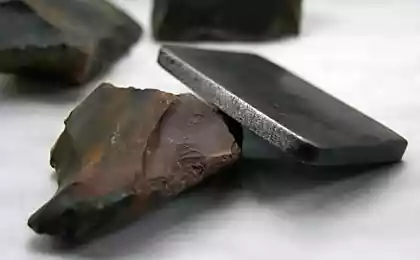461
Why skin wrinkles in water
Some parts of human skin on which the hair grows, have a unique reaction to contact with water. Unlike the rest of the body, the skin on the fingers and toes, the palms and soles wrinkled after getting wet. Usually it is enough five minutes.
But why are these areas of skin wrinkle? Some believe it's a biochemical reaction, osmotic process in which water to extract the chemicals from the skin, and the skin dries out.
But already a hundred years ago scientists knew that this reaction was not due to a simple reflex or the result of osmosis.

Surgeons found that if you cut certain nerves in the fingers, wrinkled skin effect disappears. Therefore, this effect is associated with a working nervous system. As a result, this effect is even suggested to use as a test for the efficiency of the sympathetic nervous system in patients who do not respond to other impacts.
So on this issue the scientific community has reached consensus. But the reason why in the course of evolution there was an effect of wrinkling of the skin when wet, and is it linked with any coping mechanism remains a subject of debate.
Neuroscientist mark Changizi (Mark Changizi) from 2AI Labs is confident that this effect is adaptation. Remember the pattern on the surface of the tire. In dry weather slick tires to better adhere to the asphalt, so the racing cars tyres smooth, without a pattern. But when driving in the rain tire pattern become safer.
In 2011 Changizi colleagues found evidence that wrinkled fingers actually work with tires similar way, taking the water from the fingers of the hands and feet in wet conditions, and allowing the primates — particularly humans and monkeys — to retain a reliable grip.
In other words, wrinkles that appear from exposure to water, can be considered a tiny system for the removal of fluid. The river consists of pouring into her streams and the land between the streams are not related to each other.
To check if the wrinkled skin on fingers in a branching river system, Changizi team studied 28 images of human fingers. They found that the figure shrivelled finger is an inverted copy of the river systems — it has raised areas are linked, and between them is located are not associated tubules.

The lifts are located not anyhow; their figure completely comprehended. Rivers accumulate water, and the tubules of the fingers needs to take her. Press a finger tip on a wet surface removes fluid from under him, through the canaliculi, and then the whole finger gets contact with the surface," he described the effect the researchers.
Also, wrinkles do not appear within the first five minutes after getting wet, so accidental contact with water takes its toll. This reaction occurs only in the rain or while dew. In addition, fresh water wrinkles appear faster than from the sea — perhaps this echoes the conditions in which this mechanism first appeared in primates.
Even if this mechanism occurred, and not directly to enhance the grip, it can be preserved for this reason. A study from 2013, conducted by the British neuroscientists found evidence that wrinkled fingers help people to work with wet objects.
In the experiment, 20 people had to move the 45 objects of different sizes — pebbles and sinkers from one container to another. In some cases they were dry, and the skin in different subjects was as smooth and wrinkled. In other cases, the objects were wet. It was discovered that wrinkled fingers to move wet objects easier, and to dry the objects didn't make any difference.
However, a similar study conducted in 2014 by the German researchers found the opposite effect. 40 people bore 52 of the ball and cube different sizes and weights between the containers. The researchers found no difference in the ability to handle these objects, regardless of whether the subjects fingers are wrinkled or not, and the object is dry or wet.
Similarly, the group of Taiwanese researchers conducted experiments with volunteers. They measured friction between a smooth surface and its smooth or wrinkled fingers. They also tested the ability of the subject to make ends spring together. They found that in every test the results were worse at work wrinkled fingers.

Of course, if the effect of wrinkling is a result of adaptation, it was tested in more natural conditions than laboratory.
"The society of the spectacle": what we warned, guy Debord in 1967
What is the meaning of the main Russian insults
Cangini believes that this effect is useful for maintaining weight loss whole body and not for manipulation of small objects. "If we conduct tests where the effect is set, then this need to cling to trees or heavy objects, but not for balls," he says. — (When you transfer the balls between the containers) hydroplaning does not threaten you". You need to associate this effect with the movement, not dexterity.
It turns out that the ideal experiment, in his words, is to recruit fans of parkour, shows how its tricks with smooth and with wrinkled skin, alternately dry and wet conditions. "Just as it is necessary to ensure their safety," he adds.published
Source: geektimes.ru/post/280298/
But why are these areas of skin wrinkle? Some believe it's a biochemical reaction, osmotic process in which water to extract the chemicals from the skin, and the skin dries out.
But already a hundred years ago scientists knew that this reaction was not due to a simple reflex or the result of osmosis.

Surgeons found that if you cut certain nerves in the fingers, wrinkled skin effect disappears. Therefore, this effect is associated with a working nervous system. As a result, this effect is even suggested to use as a test for the efficiency of the sympathetic nervous system in patients who do not respond to other impacts.
So on this issue the scientific community has reached consensus. But the reason why in the course of evolution there was an effect of wrinkling of the skin when wet, and is it linked with any coping mechanism remains a subject of debate.
Neuroscientist mark Changizi (Mark Changizi) from 2AI Labs is confident that this effect is adaptation. Remember the pattern on the surface of the tire. In dry weather slick tires to better adhere to the asphalt, so the racing cars tyres smooth, without a pattern. But when driving in the rain tire pattern become safer.
In 2011 Changizi colleagues found evidence that wrinkled fingers actually work with tires similar way, taking the water from the fingers of the hands and feet in wet conditions, and allowing the primates — particularly humans and monkeys — to retain a reliable grip.
In other words, wrinkles that appear from exposure to water, can be considered a tiny system for the removal of fluid. The river consists of pouring into her streams and the land between the streams are not related to each other.
To check if the wrinkled skin on fingers in a branching river system, Changizi team studied 28 images of human fingers. They found that the figure shrivelled finger is an inverted copy of the river systems — it has raised areas are linked, and between them is located are not associated tubules.

The lifts are located not anyhow; their figure completely comprehended. Rivers accumulate water, and the tubules of the fingers needs to take her. Press a finger tip on a wet surface removes fluid from under him, through the canaliculi, and then the whole finger gets contact with the surface," he described the effect the researchers.
Also, wrinkles do not appear within the first five minutes after getting wet, so accidental contact with water takes its toll. This reaction occurs only in the rain or while dew. In addition, fresh water wrinkles appear faster than from the sea — perhaps this echoes the conditions in which this mechanism first appeared in primates.
Even if this mechanism occurred, and not directly to enhance the grip, it can be preserved for this reason. A study from 2013, conducted by the British neuroscientists found evidence that wrinkled fingers help people to work with wet objects.
In the experiment, 20 people had to move the 45 objects of different sizes — pebbles and sinkers from one container to another. In some cases they were dry, and the skin in different subjects was as smooth and wrinkled. In other cases, the objects were wet. It was discovered that wrinkled fingers to move wet objects easier, and to dry the objects didn't make any difference.
However, a similar study conducted in 2014 by the German researchers found the opposite effect. 40 people bore 52 of the ball and cube different sizes and weights between the containers. The researchers found no difference in the ability to handle these objects, regardless of whether the subjects fingers are wrinkled or not, and the object is dry or wet.
Similarly, the group of Taiwanese researchers conducted experiments with volunteers. They measured friction between a smooth surface and its smooth or wrinkled fingers. They also tested the ability of the subject to make ends spring together. They found that in every test the results were worse at work wrinkled fingers.

Of course, if the effect of wrinkling is a result of adaptation, it was tested in more natural conditions than laboratory.
"The society of the spectacle": what we warned, guy Debord in 1967
What is the meaning of the main Russian insults
Cangini believes that this effect is useful for maintaining weight loss whole body and not for manipulation of small objects. "If we conduct tests where the effect is set, then this need to cling to trees or heavy objects, but not for balls," he says. — (When you transfer the balls between the containers) hydroplaning does not threaten you". You need to associate this effect with the movement, not dexterity.
It turns out that the ideal experiment, in his words, is to recruit fans of parkour, shows how its tricks with smooth and with wrinkled skin, alternately dry and wet conditions. "Just as it is necessary to ensure their safety," he adds.published
Source: geektimes.ru/post/280298/























